
Atlas F1 Technical Writer
As the first race in Europe, the San Marino Grand Prix typically sees the teams bring new mechanical solutions - and Imola this year was no different. At the centre of the technical focus were wings - new and banned. Atlas F1's Craig Scarborough analyses the changes seen last weekend and reviews the cars' performance
Warmer weather over the opening few days lead to expectation for the Michelin runners, while race day again saw track temperatures dropped by ten degrees, once more favouring Bridgestones.
As the first European race of the season, all the teams have had a chance to return to their testing regime and many arrived in San Marino with new developments. Also, the rise of the BAR team's pace lead to other teams seeking clarification on some of their aerodynamic tweaks.
Rear wing clarification
Due to a technical clarification that sent to the teams on the Thursday prior to the San Marino Grand Prix, the fences on the BAR and Williams rear wings were deemed outside the regulations and were effectively banned.
This year the rear wing regulations were revised to allow only two elements on the top of the rear wing, in the rulebook the FIA does not state what constitutes an element, simply using the term a “closed section” that doesn’t attempt to explain the shape or form of the wing.
This vague approach is a deliberate policy of the FIA, as it allows for later “clarifications” to be made to react to teams' interpretations of the basic rule. Often when teams have a solution that they feel is on the limit of what the rules allow they present it to the FIA technical delegate Charlie Whiting, who will approve or reject solutions based on whether he feels they are within the spirit of the regulations. Equally, when teams run a new solution in a Grand Prix, it can be protested by other teams or the FIA itself. Whiting’s interpretations of the rule often go back to the FIA's fundamental view of how an F1 car should look and work, hence more radical or unconventional solutions are often within the wording of the rules but are later placed outside the rules after a “clarification”.
In last week's clarification, the FIA has explained what it considers to constitute a wing element. According to Whiting, a wing element - which we would understand as an aerofoil profile - needs to be formed of two surfaces; one upper and one lower surface. This needs to be across the full width of the wing, and although the shape may change, the number of surfaces should be consistent.
In Testing, BAR had also tried a wing with multiple (20) fences that would have enhance the effect even further. While the rear used in the Silverstone test also sported a third element, it is not clear if this was to hide the multiple fences or was a part of the design to effectively create an extra element by adding it to the rear flap.
Team by Team
Ferrari
With only imperceptible changes to the successful F2004, Friday started out with the Bridgestones typically reacting well to fresh track and setting the pace. The afternoon session saw the Michelin teams catch up, allied to Rubens Barrichello's dissatisfaction with his set up.
Qualifying went well by most teams' standards - Michael Schumacher struggled in the first session on a dirty track and Barrichello was happier with his set up – but the second qualifying session saw Barrichello set a better pace, losing out with a poor third sector, while Schumacher knew he needed to push to improve over Jenson Button's time and subsequently made an error through Variante Alta.
The races start saw both drivers with good starts but poorer runs to the first corner against the Williamses in particular. This might have been attributed to fuel load which was a few laps heavier than qualifying had suggested. Additionally, the Bridgestones needed a few laps to come-in. For the balance of the race, however, Schumacher was trouble-free and Barrichello's car lacked the required performance advantage both in terms of straight-line, braking and pit strategy to re-pass his rivals.
Renault
Little changed in Renault's relative pace to their rivals, despite some detail aero changes to the floor, rear wing and bargeboards, as well as a major new engine spec - incorporating “cylinder heads, inlet system and the bottom of the engine”.
Friday and Saturday went without drama but also without a perfect set-up. The race equally went without technical hitches - bar some brake problems late in the race for Jarno Trulli - resulting in two good race finishes for the new engine.
BAR
Friday went well for BAR. All three drivers completed trouble-free laps and at a similar front-row pace. Qualifying saw the two race drivers in similar form; Takuma Sato's more erratic lap in the second qualifying put him down the field, while Jenson Button's clean lap – along with errors made by his rivals - saw him post his and BAR's maiden pole position.
After two clean race starts, Button was able to run a leading pace, only topped when Schumacher stopped two laps later than the Briton. Meanwhile, Sato had a queue forming behind him as he started to experience gearbox problems, with his race finally ending five laps before the end, with a major engine failure.
Williams
As with most Michelin runners, Friday's afternoon session saw better pace from Williams, and the team could move forward with set up and tyre choice. Qualifying saw the cars further tweaked form Friday and good clean laps by both driver saw them up the front, if not the top Michelin runners.
In the race, after a good first lap, both cars struggled to keep the pace of the leading cars, leaving Juan Pablo Montoya on a lonely drive and Ralf Schumacher continually fighting until he was involved in a collision with Fernando Alonso, recovering to finish the race several positions down.
McLaren
The team's troubled season saw repeats of previous problems, such as pace and trouble with brakes. Regardless, Kimi Raikkonen went well in the Friday afternoon session. Qualifying saw Raikkonen's weekend go downhill after a “leakage in an exhaust valve seating” lead the team to bring him back into the pits after only a warm up lap, in order to change the engine and refuel for the race. This forced the Finn to once again start from the back of the grid.
David Coulthard's qualifying lap was slowed by locking brakes leaving him well down the order. However, at the race start, Coulthard's better start saw him catapult down the inside of the field only to run into the rapidly slowing pack, knocking off his front wing in the process and forcing him into the pits for a nose and strategy change (to two stops). But the team can take consolation in that both cars ran to the flag.
Jaguar
Detail changes on the car included Ferrari-like outer brake ducts, dubbed “donuts” around the pitlane - although these act to improve aerodynamics rather than brake cooling, which is critical at Imola.
Friday only saw one technical hydraulic problem on Christian Klien's car, and a program aimed at set-up rather than pace. Saturday saw Klien's error at Variante Alta punished by heavy damage to the chassis, forcing a switch to the spare chassis - but fortunately with his race engine intact.
The loss of track time and unfamiliar chassis cost Klien some grid positions, while Mark Webber qualified cleanly. Webber's better start position was compromised by an electrical problem, losing engine power throughout the race. Klien's traffic problems and blue flags wrecked his tyres, but otherwise the Grand Prix yielded two race finishes - a better sign for Cosworth.
Sauber
Error and problem free opening days were only compromised with a gear problem for Giancarlo Fisichella going into the second qualifying. Again, a straightforward race saw the team only just pipped to a points finish.
Toyota
Toyota appeared in Imola with detail changes to the front and rear wings. These improved the car's balance but did not cure its problems over kerbs, which - over the past few years - has been caused by both mechanical and aerodynamic reasons. Additionally, a gearbox problem for third driver Ricardo Zonta cut down track time for the team on Friday.
Saturday followed with imperfect qualifying runs and mediocre times, preceded by an electronic problem for Olivier Panis.
Panis had an uneventful race, while Cristiano da Matta had a strange spin into the gravel. ” I was given a Drive Through penalty and followed my normal procedure when I came into the pits," the Brazilian explained. "That involves pressing two buttons - one for the pitlane speed limiter and one for the launch control. But the launch control button also disables the traction control and, of course, this time I was not actually stopping. I got to the first chicane, where I was caught out by not having any traction control and went off the circuit.” A strange explanation as well!
Jordan
Indistinguishable changes on the car brought some improvements but otherwise the car lacks the pace of the rest of the field, bar Minardi. Third driver Timo Glock damaged the spare car in a crash on Friday, but fortunately the race drivers had no problems.
Qualifying runs saw some inconsistent handling from the tyres, but otherwise both cars had clean runs. Unfortunately, the race saw a spin that may have lead to a driveshaft failure for Nick Heidfeld, and hydraulic problems disabling the power steering on Giorgio Pantano's car saw a rare double retirement for any team in 2004.
Minardi
While McLaren adopted vertical slots in the rear wing endplates, Minardi had dropped theirs for this race. Since their launch, Minardi had a long vertical slot in the end plate along the line that marks the old Endplates shape. This slot acted to mask the effect of the extended portion on the 2004 endplate, by letting flow within the endplate pass outside.
Friday went well with full distances run by the three cars. Going into qualifying, the cars' reluctance to ride over kerbs - despite the rear suspension using long torsion bars - proved the team's undoing, with both drivers struggling to negotiate Variante Alta, the second such spin for Zsolt Baumgartner of the day. Baumgartner's race was cleaner, whereas Gianmaria Bruni's brakes created problems and he had to retire.
Imola is a tough track. With many gradients, the Italian circuit demands engine power, but with the mix of slow entry corners it also puts heavy demands on the brakes. The combination of both these factors makes the circuit also heavy on fuel consumption. For the race, the requirement for three stops was inevitable but a few teams chanced a slog through a two stop race.
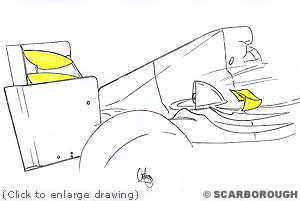 BAR had adopted a fence on their rear wing that sought to segregate the three pressure regions created by the two curves in the rear wing shape. These fences kept the drag-inducing vortexes created at the wing/endplate interface to a minimum. This provided a clear performance benefit and the other teams had stated to the FIA that they would adopt these ungainly fences if the rules allowed them.
BAR had adopted a fence on their rear wing that sought to segregate the three pressure regions created by the two curves in the rear wing shape. These fences kept the drag-inducing vortexes created at the wing/endplate interface to a minimum. This provided a clear performance benefit and the other teams had stated to the FIA that they would adopt these ungainly fences if the rules allowed them.
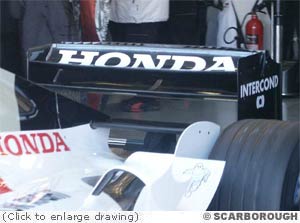 While this clarification allows the complex 3D shapes to remain, it does not allow the shape of the 'fence' used by BAR and lately Williams and McLaren, because the 'shark fin' shape consists of one more surface than the rules allow (i.e. three in total). BAR's response was to change the shape of the fence to remove the sharp (two part) upper edge and create a single line curve, which still provides some of the fence effect while meeting the regulatory profile.
While this clarification allows the complex 3D shapes to remain, it does not allow the shape of the 'fence' used by BAR and lately Williams and McLaren, because the 'shark fin' shape consists of one more surface than the rules allow (i.e. three in total). BAR's response was to change the shape of the fence to remove the sharp (two part) upper edge and create a single line curve, which still provides some of the fence effect while meeting the regulatory profile.
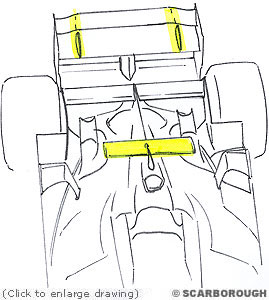 Despite being hindered by the rear wing clarification and running modified fences, the team arrived at Imola with other aero developments on the car. Firstly was the mid-wing, tested at Paul Ricard, similar in design to Ferrari's but - contrary to suggestions in the media - it was by no means copied, as BAR have run similar wings since 2001. Additionally, the team were able to split the cooling outlets, with the slim waisted outlet on the right hand sidepod and an outlet on the left. The water-only cooler in the right hand pod requires less cooling, and the truly slim shape of the sidepods was particularly apparent from above.
Despite being hindered by the rear wing clarification and running modified fences, the team arrived at Imola with other aero developments on the car. Firstly was the mid-wing, tested at Paul Ricard, similar in design to Ferrari's but - contrary to suggestions in the media - it was by no means copied, as BAR have run similar wings since 2001. Additionally, the team were able to split the cooling outlets, with the slim waisted outlet on the right hand sidepod and an outlet on the left. The water-only cooler in the right hand pod requires less cooling, and the truly slim shape of the sidepods was particularly apparent from above.
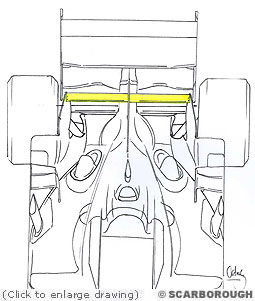 With the Williams car shorn of its rear wing fences, a small shelf wing was tried on Friday to redress the balance. But the short simple chord wing, attached to the bodywork between the rear wheels, worked to improve flow to the rear wing rather than create its own downforce. It was dropped after some trial runs.
With the Williams car shorn of its rear wing fences, a small shelf wing was tried on Friday to redress the balance. But the short simple chord wing, attached to the bodywork between the rear wheels, worked to improve flow to the rear wing rather than create its own downforce. It was dropped after some trial runs.
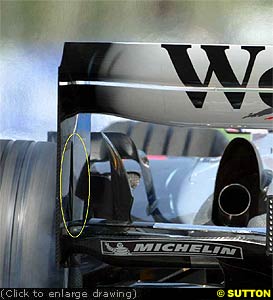 After a major aero test preceding the race, McLaren tried the flat rear wing on Friday, but not the now banned rear wing fences seen at the test. The endplates on the more commonly run complex rear wing featured a development Minardi claimed to be their own. A small slot was created on the endplate in line with the top of the wheel and shaped to let air form outside the endplate pass to the inside. The aim of this device is unknown, as the area behind the rear wheel is lower pressure and the air would not tend to want to pass through the slot. Minardi's endplate works on a totally different principle.
After a major aero test preceding the race, McLaren tried the flat rear wing on Friday, but not the now banned rear wing fences seen at the test. The endplates on the more commonly run complex rear wing featured a development Minardi claimed to be their own. A small slot was created on the endplate in line with the top of the wheel and shaped to let air form outside the endplate pass to the inside. The aim of this device is unknown, as the area behind the rear wheel is lower pressure and the air would not tend to want to pass through the slot. Minardi's endplate works on a totally different principle.
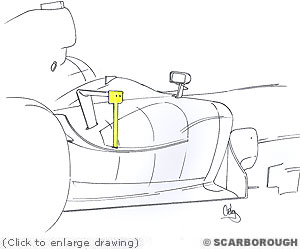 Along with the newly developed power steering, the Sauber car appeared with some new aero parts, despite their windtunnel being out of action. The aero changes included a reinforcing strut on the winglet. This is used by most teams as a flow conditioner, rather than to create downforce, which requires less support. Sauber's take on this theme, however, clearly creates a heavier loading and the need for a double support.
Along with the newly developed power steering, the Sauber car appeared with some new aero parts, despite their windtunnel being out of action. The aero changes included a reinforcing strut on the winglet. This is used by most teams as a flow conditioner, rather than to create downforce, which requires less support. Sauber's take on this theme, however, clearly creates a heavier loading and the need for a double support.
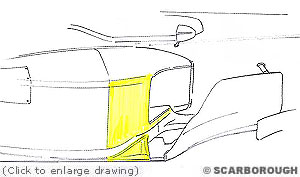 Compared to the rest of field, Minardi arrived at Imola with the biggest aero changes. Most significant are the changes to the front of the sidepod, echoing the Ferrari F2003-GA undercut shape, and the leading edge has changed - softening the frontal profile over the square shouldered original. To allow this shaping, the lower crash structure is now exposed, as well as detail changes to the floor and bargeboards.
Compared to the rest of field, Minardi arrived at Imola with the biggest aero changes. Most significant are the changes to the front of the sidepod, echoing the Ferrari F2003-GA undercut shape, and the leading edge has changed - softening the frontal profile over the square shouldered original. To allow this shaping, the lower crash structure is now exposed, as well as detail changes to the floor and bargeboards.
|
Contact the Author Contact the Editor |
Please Contact Us for permission to republish this or any other material from Atlas F1.
|
Volume 10, Issue 17
Atlas F1 Exclusive
The Next Privateer
Bjorn Wirdheim: Going Places
One Shot: a Tribute to Ratzenberger
Ann Bradshaw: Point of View
2004 San Marino GP Review
2004 San Marino GP Review
Technical Review: San Marino
Reflections on Imola
Beware Racing's Black Hole
Slim Hopes
Stats Center
Qualifying Differentials
SuperStats
Charts Center
Columns
Season Strokes
Elsewhere in Racing
The Weekly Grapevine
> Homepage |